Text and photos © 2009 by Scott W. Clemens
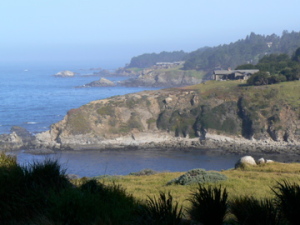 |
|
The view north from Timber Cove Inn
|
One of the things I like most about San Francisco is that you can get out of the city and into the country in short order. Within half an hour you can be on the fringes of wilderness, or if you prefer, agricultural vistas. The Sonoma Coast must be a tremendous surprise to visitors whose visions of California have been formed by Hollywood’s depiction of Southern California.
By the time you clear Petaluma, a bare half-hour out of San Francisco, you pass into the bucolic scenery of cattle and sheep farms. Each season has its beauty, but I especially enjoy this drive in May, when the hills are still green, the wildflowers are in full bloom, and the kids are still in school.
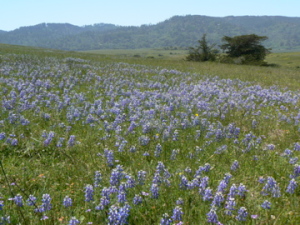 |
|
In spring, blue lupine carpets the hills just north of Point Reyes Station
|
Your first stop will be Bodega Bay. For the past forty-five years the town has traded on its fame as the setting for Hitchcock’s The Birds, and if you’re into old movies you can make a day of it visiting the sites of specific movie scenes. But Bodega Bay has gone upscale since Hitchcock’s day. Luxury hotels have sprung up on the hills overlooking the bay — Bodega Bay Lodge, The Coast Inn at Bodega Bay, and The Inn at the Tides. Sitting a little higher on the hill, the latter is a pretty property with panoramic views of the bay, an indoor/outdoor pool, sauna, gym, and large rooms with wood-burning fireplaces. The buildings are all two-stories, so ask for an upper floor, corner room — you’ll have better views and vaulted ceilings. The most private room is 1408 in Thomas Point Lodge, the highest, southeastern most room, looking out on a grassy hill to the southeast, and the bay to the southwest.
Bodega Bay was built on Highway One when it was a horse track, and thus never developed a main street, so all the funky little shops front the highway. On our last trip everyone seemed to be selling nautical knick-knacks, kites and taffy. It’s not a place to go for shopping.
Visitors to Bodega Bay should be prepared for three things: wind, fog and the foghorn. Bodega Head, a short mile across the bay from Bodega Bay, is officially the windiest spot on the west coast, and Bodega Bay gets its share. You’ll never know if you’ll arrive in the sun or the fog, but you’ll have a better chance avoiding fog if you visit anytime but the summer, which is fog season from Eureka to Monterey. As to the high pitched electronic “fog” horn, it beeps incessantly every ten seconds, day or night, fog or no fog, seven days a week. It can be annoying at first, but it’s surprising how soon you acclimate to it and tune it out.
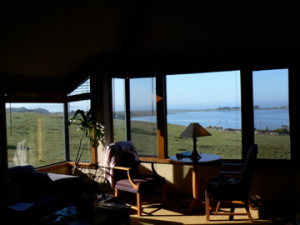
Room 1408 at Inn at the Tides, Bodega Bay, photo by Scott W. Clemens
There are about a dozen restaurants in the town. Across the highway from The Inn at the Tides is Tides Wharf, which featured in Hitchcock’s 1963 film. It burned down in 1968 and was rebuilt bigger and better. There’s a snack bar and waterside deck, a gift shop, a little market with gourmet food items and local fresh fish and crab, and The Tides Wharf Restaurant. There we enjoyed the best cioppino I’ve ever had, while being entertained by two patrolling sea lions that cruised back and forth in front of the restaurant, scaring the gulls and grebes. Cioppino is San Francisco’s Italian version of boulliabase, a tomato-based shellfish soup. Cioppino is a project best suited to adults who, as children, were reprimanded for playing with their food — it’s a messy business cracking crab in soup. I’ve often been disappointed by cioppino, which has a tendency to taste metallic and bitter, and too often features over-cooked seafood. Cioppino looks like it should be an easy, rustic dish to prepare, but great ones are rare. Here at The Tides Wharf, the ingredients are muscles, clams, scallops and Dungeness crab (another reason to visit in May, while crab is still in-season) and a marvelous broth with saffron, red bell peppers and mysterious scents and flavors that defy description.
Bodega Bay isn’t a place to go for action, but it’s a great place to go to relax and view coastal wildlife. If you want to learn more about the animals and the natural environment surrounding the town, stop by the U.C. Davis Marine laboratory for a tour (only on Fridays between 2 and 5 PM). The lab is situated on Bodega Head, across the bay and across the San Andreas Fault from the town. The town is situated on the Continental Plate, while Bodega Head is on the Pacific Plate and has different soil and the best preserved coastal prairie habitat in the U.S.
While in Bodega you might want to venture south to visit Tomales Bay. In the spring the green hills are blanketed by blue lupine and anonymous low growing flowers of yellow, orange and purple. At the south end of the bay you can fill up on oysters at Hog Island Oyster Company. At Point Reyes Station, just past the southern reaches of the bay, turn down 4th Street and stop at Tomales Bay Foods, where you’ll find Cowgirl Creamery, which features its own award winning cheeses such as Mt. Tam, St. Pat and Red Hawk, as well as other local producers like Point Reyes Blue Cheese, and Valley Ford’s Bellwether Farms sheep cheeses. Artisan cheese producers from around the world, from France to Spain and Italy are also represented.
If you travel a few miles north of Bodega Bay, you’ll come across numerous beaches that years ago were inaccessible, but today have become state parks with stairways down to the various coves. On the south side of the Russian River you’ll come to Goat Rock State Beach. It’s a seemingly innocuous stretch of beach, but it is notable for its strong undertow, rip currents and rogue waves. Seals hang out at the far northern end of the beach where the Russian River empties into the sea.
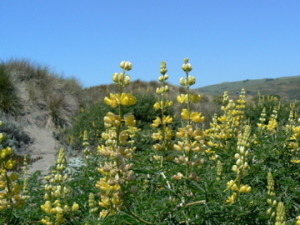 |
|
Yellow lupine grow amidst the dunes at Goat Rock State Beach
|
On the other side of the river, Highway 1 runs through a strip of buildings that constitutes the town of Jenner. Tomales Bay to Bodega Bay is characterized by rolling grass covered hills and stands of cypress trees along the shore. North of Jenner the landscape changes. The mountains loom high, and pine trees cover the slopes from peak to rocky shoreline. Just above Jenner the road climbs in a series of switchbacks up the flanks of the mountains, where you’ll be faced with a decision: Take the cliff-hugging Highway 1, or Meyers Grade along the spine of the mountains. If you take the serpentine coast road, you’ll pass through Sea Ranch and Fort Ross, the 19th century Russian fur-trading outpost.
The Spanish era gave California most of its place names. That Northern California was once claimed by Russia is a piece of history often forgotten. The original Russian building burned down about 25 years ago. What you’ll see today is a reproduction. Just north of Fort Ross, you’ll come to Timber Cove Inn, where Benny Bufano’s 93-foot-tall “Peace” sculpture projects like a totem pole from a granite outcropping.
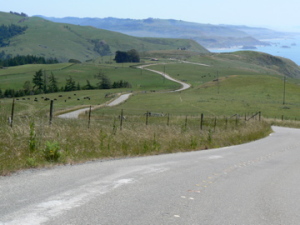 |
|
The view south from Meyers Grade
|
Had you elected to go north on Meyer’s Grade (the straighter alternative) you would come down to Highway 1 on Timber Cove Road, right at the site of the recently renovated Timber Cove Inn. This property, designed by Richard Clements and built in 1963, is a quintessential Northern California luxury lodge, dedicated to the seamless merging of comfort and rugged nature. Your room sits on a rocky bluff overlooking the ocean, and your stay will be colored by the weather. You may be shrouded in fog, blasted by wind, or bathed in sunny skies and light breezes. Each day is different. Each day is an adventure. Most rooms have gas fireplaces, Jacuzzis, panoramic ocean views, and decks.
Alexander’s Restaurant doesn’t have a large menu, but what it has is well prepared with an occasional creative turn. We enjoyed Wild Salmon on Crab Cake, Wild Mushroom Soup, Dungeness Crab Salad, and a dessert Trio of Fruit Tarts with ice creams. The selection of Sonoma County wine is excellent.
Take time to explore the 23-acre property in detail by wandering the cliff-side trails. In the spring the wild flowers are varied and abundant, and year round you can observe seals, gulls, cormorants, grebes, buzzards, hawks and crows.
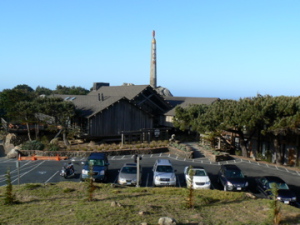 |
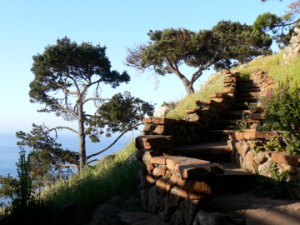 |
|
Timber Cove Inn
|
|
On the surface, the Sonoma coast is similar to Monterey — pine forest and a rocky shore. But the pines here have a subtly different scent, and the quality of light is different. Each section of California’s coast has its own distinct personality.
You can reach Point Reyes Station via Lucas Valley Road in less than an hour from the city, Bodega Bay by way of Petaluma in an hour and fifteen minutes, and the remote Sonoma Coast at Timber Cove in just over two hours. Turn off your cell phone, leave the bustle of the city behind, and warm to a slower pace of life.
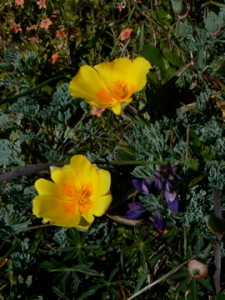 |
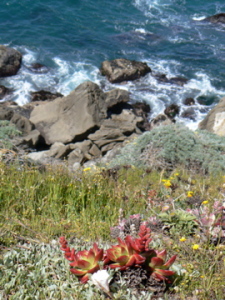 |
|
Wildflowers are varied and abundant on Sonoma’s wild coast
|
|
http://www.timbercoveinn.com/
Timber Cove Inn, 21780 North Coast Highway 1 Jenner, CA, 95450
Tel: 707.847.3231 Toll Free: 800.987.8319 Fax: 707.847.3704
Maps & Directions to Timber Cove Inn
Email: gm334@TimberCoveInn.com
Inn at the Tides, 800 Coast Highway One, Bodega Bay, CA 94923
Tel: 800-541-7788 or Fax: 707-875-2669
http://www.innatthetides.com/
& & &
